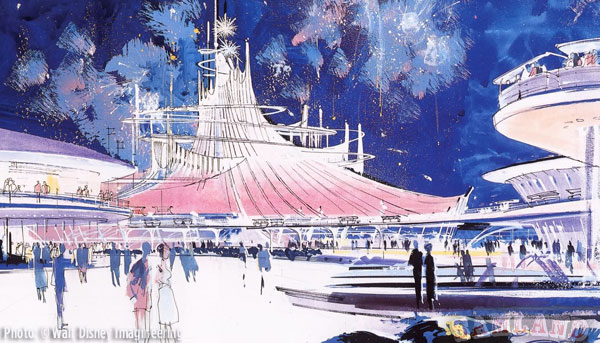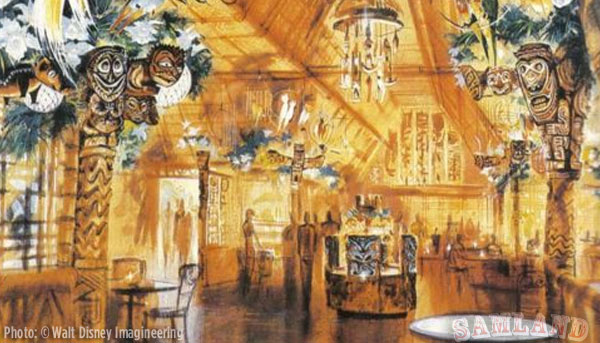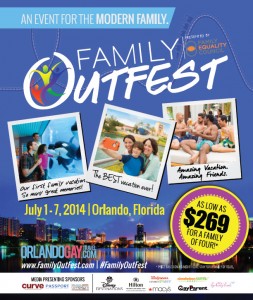Welcome to another NEW episode of Samland. This week will be a grab bag of things that have crossed my desk and sparked my curiosity. Perhaps it will inspire some of you as well. Don’t keep your comments to yourself, express them below, I always love hearing from you.
QUALITY. VARIETY. SURPRISE.
There is a difference with regards to the spatial design process, between theme parks and the world outside the front gate. Each type of environment is driven by its own distinctive organizing system, and we must define the differences so that we make the right choices to create places that are simultaneously serviceable and vibrant.
The “real” world feels alive when there is a certain disorderly vigor. A theme park succeeds when there is a lack of visual contradictions. It is virtually impossible to blend these qualities without creating a space that feels uncomfortable and undesirable.
Jane Jacobs—noted author of The Death and Life of Great American Cities and savior of large areas of historic Manhattan—described “the city as organized complexity.” Among other factors, architect Robert Venturi came to the conclusion that successful and dynamic urban environments contain a “messy vitality over obvious unity.” Both agree that it is this quality that is necessary if a place is to feel authentic and resonate with meaning to the users. Such places are embedded with quality, variety, and surprise. As a result, the environment puts you slightly on edge, and you feel more alert and alive in a delightful way. There is a delicate balance, however. Too much of this messy vitality and you will only encourage fear.

When asked about this difference, Imagineer John Hench said, “Most urban environments are basically chaotic places, as architectural and graphic information scream at the citizen for attention. This competition results in disharmonies and contradictions that…cancel each other [out].” He warns, “A journey down almost any urban street will quickly place the visitor into visual overload as all of the competing messages merge into a kind of information gridlock.”
Hench suggested that the only way to design a successful themed environment is to eliminate any visual contradictions. He defined a visual contradiction as “the active clutter that you see in the real world, which creates mixed messages, sets up conflicts, creates tension, and may even feeling threatening.” Hench taught his team, “If visual details disagree, guests experience active clutter, which has the same effect on the eye as a cacophony of noises has on the ear.” Hench elaborated, “Walt wanted all the details to be correct.” “What it amounted to was a kind of visual literacy.” He suggested that each space is like a “bead or charm in a necklace. The same thing was applied as you walk around the park. Continuity was the same. Whether you’re slow or fast, what you look at is the same.” This never-ending aspiration to eliminate every visual contradiction was in complete harmony with Walt’s vision. One day, early in the park’s history, while Walt was making his usual rounds, he spotted an employee dressed in a spacesuit, walking from the backstage area near Frontierland on his way to Tomorrowland. Walt decided he needed to find a way to make sure this did not happen again. Walt did not want guests to see anything that was not specifically designed for each space. In Walt’s mind, this was a disconnect that destroyed the carefully constructed theme, and that was unacceptable.
By eliminating the visual contradictions, Walt had created a world that was safe, clean, and existed within the earthen berm that surrounded his park. What he created was not a place about fantasy but a place about a sense of reassurance. Michel Sorkin, author of Variations on a Theme Park, noted that “The highly regulated, completely synthetic vision provides a simplified, sanitized experience that stands in for the more undisciplined complexities of the city.” Walt himself said, “Physically, Disneyland would be a small world in itself—it would encompass the essence of the things that were good and true in American life. It would reflect the faith and challenge of the future, the entertainment, the interest in intelligently presented facts, the stimulation of the imagination, the standards of health and achievement, and above all, a sense of strength, contentment, and well-being.” John Hench said that Disneyland “tried to present an undilutedly rosy view of the world; contradiction or confusion were qualities the planners of Disneyland associated with the defective, poorly planned, conventional amusement park.” He added, “Disneyland offered an enriched version of the real world, but not an escapist or an unreal version. We program out all the negative, unwanted elements and program in the positive elements. We’ve taken and purified the statement so it says what it was intended to.”

Evangelist Billy Graham once told Walt that Disneyland was “a nice fantasy.” This did not sit well with Walt. He replied, “You know the fantasy isn’t here. This is very real…The Park is reality. The people are natural here; they’re having a good time; they’re communicating. This is what people really are. The fantasy is—out there, outside the gates of Disneyland, where people have hatreds and people have prejudices. It’s not really real!”
The park is made up of a series of spaces that unfold before you. Hench said, “You begin with the first scene and move through. You don’t throw people into the fifth scene, where they cannot make sense of what is happening.” The payoff is a sense of welcoming, worth, value, and security.
When somebody suggested the only reason people go to Disneyland was escapism, John Hench took offense and disagreed. He said, “There was never a Main Street like this. But it reminds you of some things about yourself.” He added, “What we are selling is not escapism, but reassurance.” A visit to Disneyland reassures us that things will be okay. Here, everything works, places can be clean, people can be nice, and the pace of the world feels right. Marty Sklar and John Hench have described the urban design for Disneyland as the “architecture of reassurance.”

This quality is achieved by removing visual cues with messages that do not embellish the pre-determined narrative. In a concept drawing of Main Street, U.S.A. from 1953, artist Dale Hennesy included a church. Such a Main Street building would have been common and historically correct in a “real” civic center. However, Walt was not designing a reflection of a real town. He was designing Disneyland; Walt decided the church did not support the story, so there is no church at the edge of the Disneyland commercial district. Every tiny detail came under similar scrutiny from Walt. For example, when Bill Martin showed Walt drawings of Main Street, “[Walt] went over my plans with a fine-tooth comb. I’d drawn sidewalks on the blueprints with square corners and Walt said: ‘Bill, people aren’t soldiers! They don’t turn in at sharp angles! Curve the sidewalks! Make the corners round!’”
THE IMAGINEERING FIELD GUIDE TO DISNEY CALIFORNIA ADVENTURE
I really like the Imagineering Field Guide series. For those unfamiliar, for many years Disney has been producing these pocket size guide books that highlight the Imagineers creativity in creating the theme parks. The format is features, advantages, and benefits with lots of little, teeny, tiny, microscopic drawings. I use a magnifying glass. You learn what Imagineering does and they try to explain why they do it that way. The series has been running long enough that a couple of the parks are on their second edition.
The latest book is all about Disney California Adventure. This one was announced a long time ago when the park was known as Disney’s California Adventure (did you figure out the huge change in name?) but they waited until the makeover was complete to publish.
And that is the part of the book I want to talk about. How would Disney describe the massive changes to the park from its grand opening? Would Disney even talk about it? The answer is yes and yes. In a chapter called A New Vision, they acknowledge that a lot has changed from 2007 to 2012. But it is the rationale for the change that I thought was well stated:
“The Park was originally envisioned as a counterpoint to Disneyland – a different offering with a distinct tone and selection of experiences intended to provide variety for guests at the resort. But the proximity of Disneyland pointed out that there are elements of the Disney Park Experience that Disney California Adventure – in its original incarnation – did not possess. It became clear that for our guests these elements were essential in order to create the connection that they feel to our parks.”
The book goes on to explain that the lack of story was the culprit and the park “was not yet striking all the notes that we want our Parks to hit upon.” After spending a few bucks, that is precisely what they have done. And it works. I am a huge fan of Buena Vista Street. I think it is one of the most people friendly entrances to any Disney park. perhaps somebody from Florida will come to DCA and notice they have benches and places for people to sit at the park entrance. Something woefully lacking at the Magic Kingdom.
Now, if you are looking in DCA for the book, good luck. Very few knew of the book and none were to be found. One guy even called somebody and they said they never heard of it. Fortunately, there were some tucked away at Disneyland. Lesson: Go to Disneyland to buy a book about DCA. It is worth the adventure. Disclaimer: I bought the book at Disneyland.
OTHER FUN STUFF
- If you are a fan of the history of early Disneyland and Walt Disney World, then you owe it to yourself to visit Dexter Francis’s new blog about Arrow Development (http://arrowdevelopment.blogspot.com). Arrow is the ride development company that Walt trusted. The site has all sorts of rare photographs, drawings, and publicity materials. Some have not seen the light of day in over 50 years. Dexter is writing an article for MiceChat right now and will soon join us with his awesome collection of photos and information.

- There are many different pride/LGBT events around the world, but there are not many that celebrate just families. Family Outfest wanted to create a family friendly event that did just that. They are putting together a festival at Walt Disney World for July 1st through the 7th, 2014. To keep the cost down they have received sponsorships from the Family Equality Council, Disney Destinations, Nickelodeon Suite’s Resort, Hilton Lake Buena Vista, Curve Magazine, Connextions Magazine, Passport Magazine, Macy’s, Gay Parent’s Magazine etc. Some of the hotels participating are up to 50% off. They are anticipating 500+ families and they hope to give families the ability to experience the wonders of Orlando on a budget and create lasting friendships of a life time.
If you enjoyed today’s article, you might also like my two recent books:
I hope to see you all again very soon!


You must be logged in to post a comment.